 
BOWLES OVER-THE-CAB LIFT ARMS
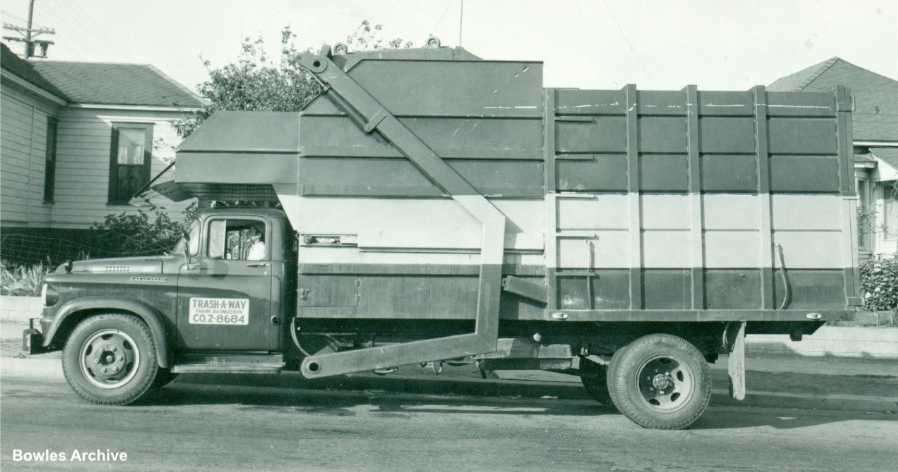
In the late 1950s, Bowles began building Over-The-Cab (OTC) lift arms for front loaders, so-called because of the way they were formed to completely clear the cab doors of the truck during all phases of the lift cycle. OTC lift arms were a tremendous improvement over the original "straight" arms. They reduced the possibility of personal injury and cab damage caused by contact with the moving arms, and eliminated the possibility of drivers being trapped in the cab during the lift cycle. OTC arms also alleviated the need for power-retracted rearview mirrors. Designated model FL-3 (with bottom forks) and model FL-4 (with side forks), Bowles OTC lift arms were available as $113.00 options on all models. The full-pack bodies received FL-4 arms as standard equipment. On models equipped with original style straight lift arms, power-retracted mirrors were included at no charge.
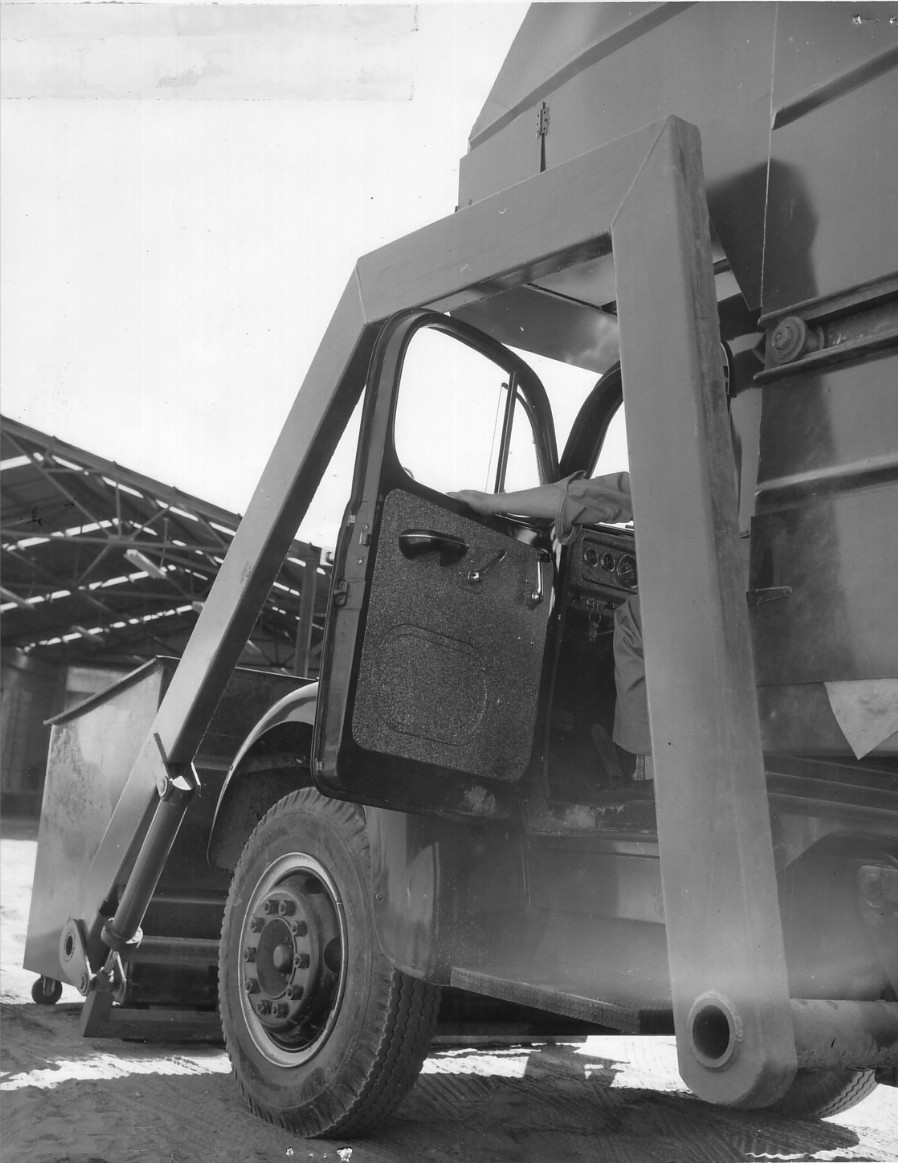
Detail photo showing how OTC lift arms completely clear the cab doors in all positions
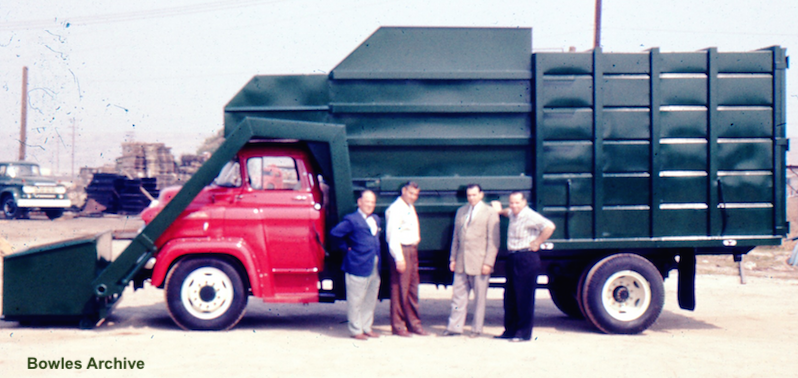
1959 GMC equipped with OTC arms
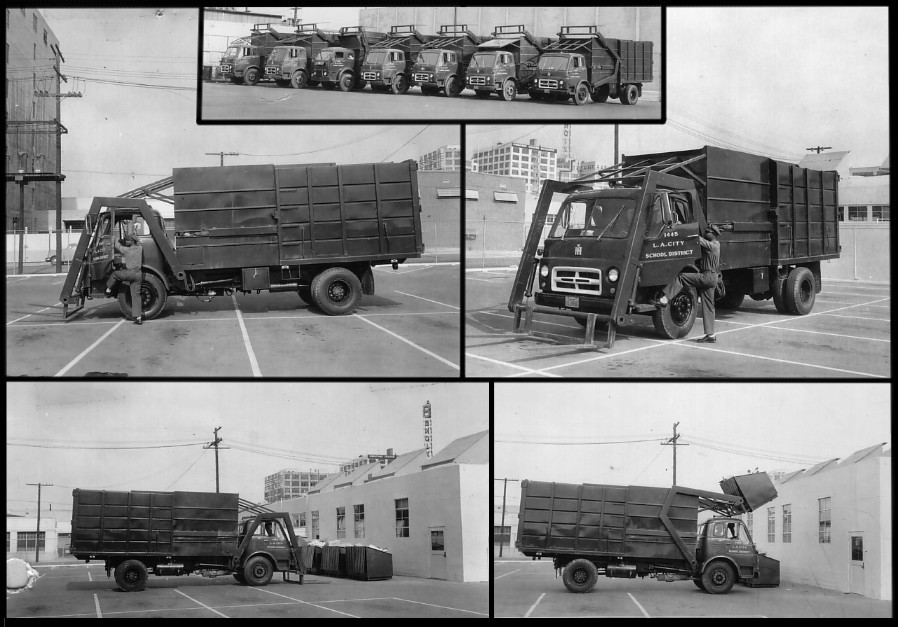
The Los Angeles City School District owned a fleet of Bowles front loaders, most with OTC arms
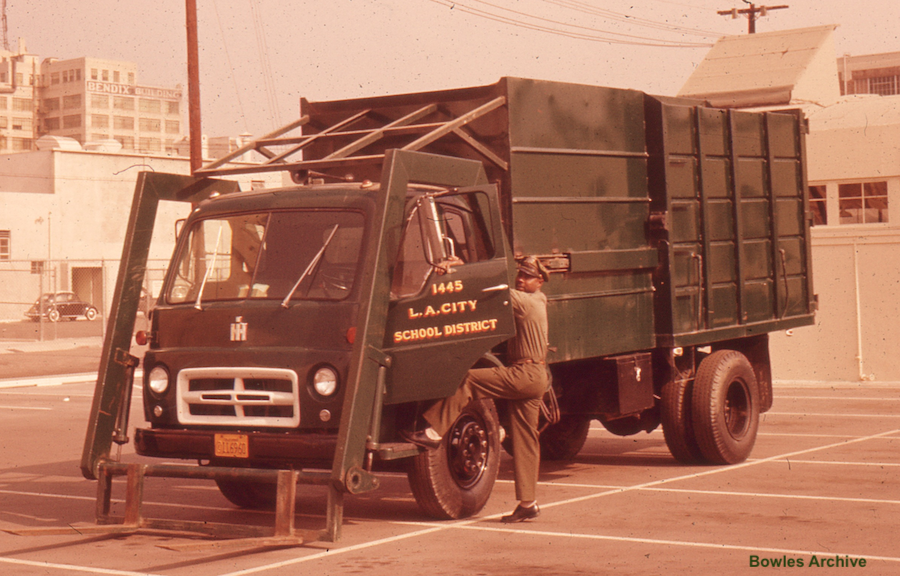
Color image of a Los Angeles City School District packer
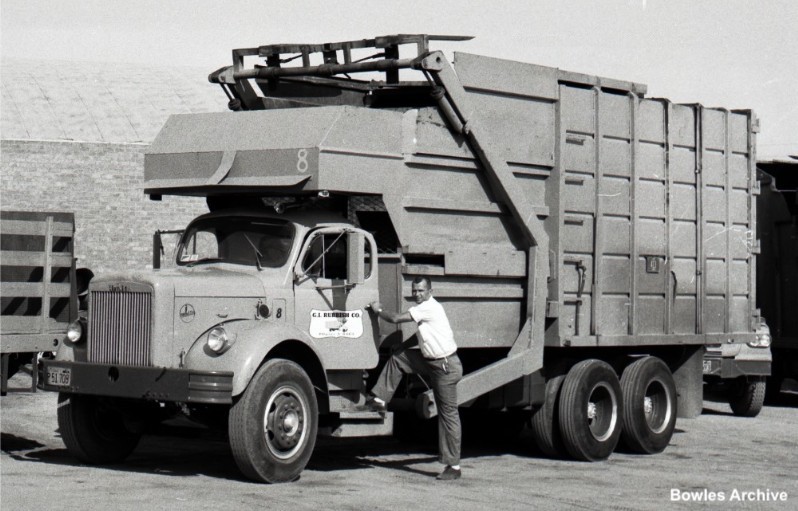
G.I. Rubbish Co, front loader with OTC lift arms
|
TRASH TRUCK WARS: THE LEGAL BATTLE OVER LIFT ARMS
During the 1950s, Dempster Brothers of Knoxville, Tennessee, had been developing a front load refuse system. By 1955, in collaboration with the Ernest Holmes Co., The Dumpmaster front loader debuted using a center-hinged lift arm, which connected to containers by top-mounted pins. (1) Although innovative for the time, this system had major drawbacks, and Dempster set about to improve the Dumpmaster shortly afterward. Dempster's engineering team included William Herpich, who had designed the Hydro E-Z Pack compaction body. This style body would become the platform for the revised 1957 Dumpmaster, a heavy-duty box with a full-packing telescopic ram. Also new were over-the-cab (OTC) lift arms, which Dempster dubbed the Clearance Arm (or "CA" for short) in their literature. By 1959, Dempster had been granted several patents, including one that covered the CA arms.
Dempster was obviously determined to grab a big piece of the lucrative southern California market for refuse trucks, having already established a west coast division in Compton. Armed with their newly approved patents, they filed an infringement suit against Bowles, and a consent decree was issued preventing Bowles from selling their FL-3 and FL-4 OTC lift arms. A consent decree indicates that Bowles voluntarily agreed to cease production of the OTC arms, but did not admit to having infringed Dempster's patent. This was probably the best Bowles could hope for at the time, since a long court battle would have been costly. Dempster's strategy seems obvious; by going after Bowles, the biggest of the western independents, they would discourage any of the other smaller firms that might have attempted to market their own OTC arms.
Dempster was, at least for the moment, triumphant in the war over OTC arms. However, despite this setback, Bowles and the other California builders (including Western Body and the upstart Bemars) not only survived the early 1960s, but also thrived. These independent builders had a close personal relationship with their customers, and were able to build equipment to suit the specific needs of the southern California market. They simply continued to use the old straight lift arm design, which most everyone was used to anyway.
Back in the east, former Bowles distributor Arthur Bausenbach (Buffalo Metal Container Co.) was developing a new front loader built around the Hydro E-Z Pack body, and using an OTC lift arm. Not surprisingly, the Bausenbach front loader was the subject of an infringement suit brought by Dempster. In an interesting David-versus-Goliath turn of events, Bausenbach counter-sued Dempster, and actually prevailed!

Left: 1959 Dempster CA-15-DB. Right: 1962 Bausenbach Flex-Arm
Bausenbach, like everyone else, could not argue with the fact that Dempster had a patent on the OTC style arms. Instead, they argued that the patent in question was invalid, because the OTC arm was simply an improvement to the prior art. The court agreed, finding that Dempster's OTC arm, being bent to clear the cab, was only the logical progression of the old straight arms, which had been in use since the early 1950s. Depositions for the plaintiffs came from a veritable "who's-who" of Los Angeles haulers and truck builders, including Western Body & Hoist, Cook Brothers and none other than Vince Bowles himself!
Simply stated, the court found that Dempster's gooseneck-shaped "C-A" (OTC) arm could not be patented because it was merely an improvement over existing "straight" arms available at the time of invention, and that this improvement would have been obvious to any person with ordinary skill in the art of truck body design. Photo evidence of a truck built by Western Body & Hoist for P.D. Hamlin Disposal (2) in 1954 (which easily pre-dated Dempster's 1957 patent application) was introduced, showing how straight lift arms had evolved to curve around wheel wells and under the doors of the truck cab, when in the lowered position. The court asked Dempster's expert witness how he, when presented with the Western truck, would have solved the problem of clearing the cab doors during all stages of the lifting process. He replied "I would be rather dumb if I didn't consider it [over-the-cab arms] as a possibility."
Other aspects of Dempster's patents were also declared invalid on the basis of prior art, including the torque tube, side forks and container sleeves. Vince Bowles' deposition provided further proof of Bausenbach's prior art claim. Bowles testified that he had in 1955 built loaders employing hydraulically actuated side forks engaging channels in detachable containers, which were sold to Lawndale Disposal (3) and Antelope Rubbish Company. Photos of these trucks, as well as sales records and the buyer's testimony backed him up. In all, ten claims from Dempster's patent were found to be invalid because of prior art, or (in the case of the OTC arms) were found to obvious improvements.
Dempster appealed the findings, but in November of 1965, the U.S Court of Appeals 2nd Circuit Court upheld the District Court's earlier judgment. (4) The way was once again cleared for all manufacturers to offer the safer OTC arms without fear of a lawsuit. In this case, the 'Goliath' (Dempster) had been vanquished by an unlikely 'David' (Bausenbach). It is fitting that the testimony of Vince Bowles and the other California independent builders was instrumental in swaying the court. The justices acknowledged that Dempster's "C-A" arm was the solution to the problem of lift arm clearance of the cab doors, but that this was merely the evolution of the existing "straight" lift arm, and thus, not patentable.
Dempster's contributions to front loader development should not be minimized, and it would appear that they can rightfully lay claim to pioneering the OTC arm (as spawned from the existing straight lift arm) which has become the industry standard. However, the court found, and history has supported what Vince Bowles knew all along; that Dempster's claim that the technology didn't exist in any form in 1955-1956 was not only outrageous, but also laughable.
Footnotes:
(1) See the page on the Early Dumpmaster in the Dempster Album here at Classic Refuse Trucks
(2) Details about this truck are not currently known. Presumably it was a non-compaction model. This "double S" lift arm, as the court transcript describes it, may refer to a common shape of arm later used on almost all front loaders mounted on cab-over-engine trucks in the late 1950s through mid 1960s. Cab-over-engine trucks were seldom used as front loaders because conventional-cab trucks offered a better front end counterbalance when tipping the body on a landfill. This 1954 Western arm may have even been a custom job made by request for Hamlin.
It is possible that the special front loader arm made for a L.A. City E-Z Pack in 1956 was a variation of the 'Hamlin' arm made by Western, or an imitation. However, this cannot be confirmed and is merely speculation.
(3) The Lawndale Disposal truck, presented as evidence during the court proceedings may in fact be the same truck shown in the first chapter of this article (The Bowles Album) here at Classic Refuse Trucks.
(4) For further details, see the complete transcript of the ruling of the Appeals Court in 352 F2d 420 "Dempster Brothers Inc v. Buffalo Metal Container Corporation"
|



1/17/10
© 2010
All Rights Reserved
Logos shown are the trademarks of respective manufacturers
Photos from factory brochures/trade advertisements except as noted
|
| |